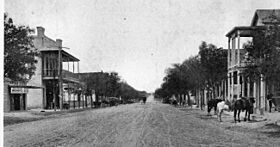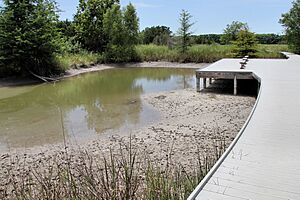Boerne, Texas facts for kids
Quick facts for kids
Boerne, Texas
|
|
|---|---|

Main Street in Boerne, Texas, c.1890-1900
|
|
| Country | |
| State | |
| County | Kendall |
| Settled | 1849 |
| Government | |
| • Type | Council–manager |
| Area | |
| • Total | 11.98 sq mi (31.02 km2) |
| • Land | 11.67 sq mi (30.23 km2) |
| • Water | 0.30 sq mi (0.79 km2) |
| Elevation | 1,447 ft (441 m) |
| Population
(2020)
|
|
| • Total | 17,850 |
| • Estimate
(2021)
|
19,109 |
| • Density | 1,490.0/sq mi (575.44/km2) |
| Time zone | UTC-6 (Central) |
| • Summer (DST) | UTC-5 (Central) |
| ZIP codes |
78006, 78015
|
| Area code(s) | 830 |
| GNIS feature ID | 2409874 |
| FIPS code | 48-09160 |
Boerne (pronounced BURN-ee) is a city in Texas, United States. It is the main city of Kendall County. Boerne is located in the beautiful Texas Hill Country.
The city is known for its German-Texan heritage. It was named after a German writer and satirist named Ludwig Börne. The population of Boerne was about 10,471 people in 2010. By 2020, it grew to 17,850 people. Boerne was first settled in 1849 and was called "Tusculum." Its name changed to "Boerne" in 1852.
Contents
Discovering Boerne's Past
Boerne started as a place for "Free Thinkers" from Germany. These were people who believed in freedom and new ideas. They came to Texas after the Revolutions of 1848 in Germany. Many of them were educated and enjoyed talking about science, philosophy, and music.
How Boerne Got Its Start
In 1849, some German colonists camped near Cibolo Creek. They named their new camp "Tusculum," after an ancient Roman home. In 1852, two men, John James and Gustav Theissen, planned the town. They renamed it "Boerne" to honor the German writer Karl Ludwig Börne. The town officially became a city in 1909.
Boerne During the Civil War
During the American Civil War, Boerne was mostly against leaving the Union. Many people in Kendall County supported the Union and Abraham Lincoln.
Historic Buildings and the Railroad
The old limestone courthouse in Boerne was built in 1870. It is the second-oldest courthouse in Texas. In 1887, the San Antonio and Aransas Pass Railway came to Boerne. This helped the town grow and brought new opportunities.
Boerne's Famous Band
The Boerne Village Band was started in 1860 by Karl Degener. This band is known as the "Oldest Continuously Organized German Band in the World outside Germany." In 1998, Germany recognized the band for keeping German heritage alive in Texas and America.
Exploring Boerne's Geography
Boerne is located in the southern part of Kendall County. It is part of the scenic Texas Hill Country. Interstate 10 and U.S. Route 87 pass near the city center. These highways connect Boerne to San Antonio and other towns.
Boerne's Waterways and Caves
Boerne covers about 11.98 square miles (31.02 square kilometers). A small part of this area is water. Cibolo Creek, a 96-mile-long river, flows through the city.
There are also two amazing show caves near Boerne:
- Cave Without a Name is about 10 miles northeast.
- Cascade Caverns is about 3 miles southeast.
Both are limestone caves that are still growing.
Boerne's Climate: What's the Weather Like?
Boerne has a humid subtropical climate. This means it has hot, often humid summers. Winters are usually mild, but can sometimes be cold. Snowfall is very rare. The hottest temperature ever recorded was 112°F (44°C) in August 1925. The coldest was -4°F (-20°C) in January 1949.
Summer months can be dry or humid. Sometimes, storms from hurricanes can bring a lot of rain. The wettest month ever was July 2002, with over 28 inches (722 mm) of rain.
Who Lives in Boerne?
| Historical population | |||
|---|---|---|---|
| Census | Pop. | %± | |
| 1870 | 250 | — | |
| 1880 | 346 | 38.4% | |
| 1890 | 433 | 25.1% | |
| 1900 | 800 | 84.8% | |
| 1910 | 886 | 10.8% | |
| 1920 | 1,153 | 30.1% | |
| 1930 | 1,117 | −3.1% | |
| 1940 | 1,271 | 13.8% | |
| 1950 | 1,802 | 41.8% | |
| 1960 | 2,169 | 20.4% | |
| 1970 | 2,432 | 12.1% | |
| 1980 | 3,229 | 32.8% | |
| 1990 | 4,274 | 32.4% | |
| 2000 | 6,178 | 44.5% | |
| 2010 | 10,471 | 69.5% | |
| 2020 | 17,850 | 70.5% | |
| 2021 (est.) | 19,109 | 82.5% | |
| U.S. Decennial Census | |||
In 2020, about 17,850 people lived in Boerne. There were 5,547 households and 3,891 families.
| Race | Number | Percentage |
|---|---|---|
| White (not Hispanic) | 12,144 | 68.03% |
| Black or African American (not Hispanic) | 185 | 1.04% |
| Native American or Alaska Native (not Hispanic) | 60 | 0.34% |
| Asian (not Hispanic) | 204 | 1.14% |
| Pacific Islander (not Hispanic) | 18 | 0.1% |
| Some other race (not Hispanic) | 70 | 0.39% |
| Mixed/multiracial (not Hispanic) | 556 | 3.11% |
| Hispanic or Latino | 4,613 | 25.84% |
| Total | 17,850 |
Fun Things to Do in Boerne
Boerne has many attractions for visitors and residents.
The Hill Country Mile
The Hill Country Mile is a 1.1-mile (1.8 km) walking path. It follows River Road Park and historic Main Street. This path helps connect and celebrate downtown Boerne's unique culture. It also helps local shops and businesses grow.
Cibolo Center for Conservation
The Cibolo Center for Conservation is a large area with over 100 acres of trails and nature. It also includes the historic Herff–Rozelle Farm. The center first opened in 1990 to protect the marshland near Boerne City Park. It offers a summer day camp for kids aged 5–12. The camp teaches about the environment and how to enjoy nature.
Boerne City Lake Park
Boerne City Lake was created in 1978 by the John D. Reed Dam. Its main goals were to help control floods and provide fresh water for the city. The lake has about 100 acres of water. Motorized boats are not allowed on the lake.
Cascade Caverns: Explore an Underground World
Cascade Caverns opened for public tours in 1932. However, people were taking private tours as early as the 1870s. Stories say that adventurous young men and even a hermit knew about the cave during the Civil War.
Learning in Boerne
Boerne is part of the Boerne Independent School District. The district has two high schools, three middle schools, and seven elementary schools. There are also private schools, like the Geneva School of Boerne. Meadowlands is a special school for young people who need extra support.
Famous People from Boerne
Many well-known people have connections to Boerne:
- Michelle Beadle, a TV sports personality.
- Jacobs Crawley, a rodeo world champion.
- Ann B. Davis, an actress from The Brady Bunch.
- Bill Goldberg, a professional wrestler.
- Matt Carriker, an American YouTuber known for Demolition Ranch.
- Herb Hall, a jazz clarinet player.
- Susan Howard, an actress from Dallas.
- George Wilkins Kendall, a journalist and war correspondent.
- Cheryl Ladd, an actress from Charlie's Angels.
- Maggie Lindemann, a singer and songwriter.
- Grace Phipps, an actress from Teen Beach Movie.
- Tammie Jo Shults, a commercial airline pilot and former Navy officer.
- George Strait, a famous country singer, songwriter, and actor.
- Jimmy Walker, a professional golfer.
- Matthew O. Williams, a recipient of the Congressional Medal of Honor.
Images for kids
See also
 In Spanish: Boerne (Texas) para niños
In Spanish: Boerne (Texas) para niños





